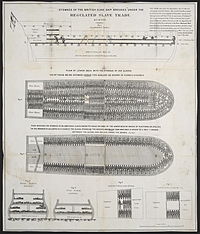From my point of view, one of the strongest contemporary artists is Romuald Hazoumé. His thematic is slavery, his medium the jerrycan. Romuald Hazoumé made famous works like ‘La Bouche du Roi”, an installation reconstructing the crammed positions of slaves on the lower deck of the ‘Brookes’, a slaveship (picture), with jerrycans. The jerrycans are made into contemporary masks – Romuald Hazoumé ‘s trademark. The masks are different, individual, to show the personality of each of the people being transported. The masks have voices, calling out in the languages of Bénin. About the use of the jerrycans, Romuald Hazoumé is recorded having said: “I send back to the West that which belongs to them, that is to say, the refuse of consumer society that invades us every day.”
The artist is from Porto Novo, Bénin. Both his thematic as his means are close to him. Porto Novo was the place where slaves captured in the whole of Africa were gathered on the market, sold and taken into ships to the West. ‘La Bouche du Roi’, meaning the king’s mouth, is the name of the place where the river Couffo flows into the ocean, the place by which the slaves were shipped out. The work speaks however not solely of the past; today, workers are brought from the same place towards stone-pits in Nigeria or cacao plantations in Ivory coast and they are not treated any better than in the slavery past, being beaten off the ships like cattle. And in the larger picture, as Romuald Hazoumé keeps repeating, it speaks about the slavery of people today, all over the world, being exploited by bosses who can decide to relocate their plants to Asia, leaving their workers, their brothers, out of jobs and into poverty. And on a more local level it speaks of the people exploited, putting their lives on the line carrying lots of jerrycans with petrol from Nigeria through Benin.
The jerrycans are leftovers from the contemporary illegal trade of gasoline, a very important business in Benin. The black market gasoline is transported in jerrycans by individual people on a bike, a motorcycle,… with hundreds of litres on every voyage. Each of these transports is a potential bomb; if any accident happens they just explode. Romuald Hazoumé took and published a lot of fascinating pictures about this trade – just click on the links to the right to check.
Other works by Romuald Hazoumé are series of masks – right now there is a show at Musée Dapper in Paris – and ‘Dream’, an installation around a boat made of jerrycan masks, modelled after the boats with which refugees from Africa try to reach Europe. With this work he won the Arnold-Bode prize at Documenta 12 in Kassel.
Although the thematics are very serious, there is a lot of humour in Romuald Hazoumés work.
If you are really interested, you can take the time to listen to a talk Romuald Hazoumé had with the public at Tate Modern in 2007. We hear a very engaged artist, not working for musea or career, but trying to make sense for his own people.
At the beginning of the talk, Romuald Hazoumé tells the public about the culture of the Fa or Ifa, the basic source of knowledge on nature (the elements) but also the human relations, the place of women in society, death, and how the sense of Fa is lost today, how people get pretentious, forgetting equality and that we are all made of earth and will return to earth.
At 15′, to the question of the place of the mask in his work, he talks about how he got to make masks (as a toy) and how he got to see them as art.
At 27′ he tells the story of how he got to photograph the people carrying the canisters with gasoline and goes on about the corrupt politicians.
Around 48’30 he elaborates on the dangers of the informal gasoline trade and draws the parallel between the old and the contamporary slavery.
At 59’10 he speaks about La Bouche du Roi and its layers of thematics, and how he made that work for his people. Also about slavery.
At 1h 21′ 10″ the theme is the complexity of his, and African, identity.
